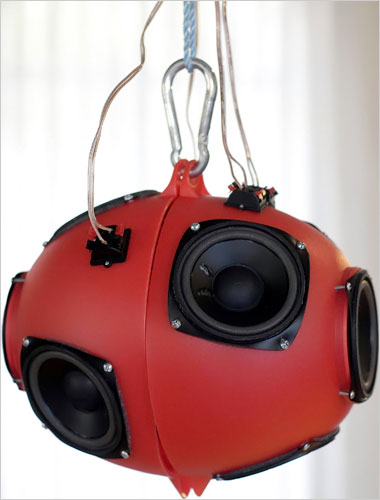Original here.
The music was fantastic last night.
Respectable Citizen started playing about 7:15. Michael Zbysznski on saxophones and electronics, Bruce Bennett on keyboards and their downstream modulation, and Byron Diel laying down one of the most absorbing 45 minutes of trap set drumming I’ve heard.
Like Stockhausen’s improvisatory group, Respectable Citizen starts with traditional musical instruments, feeding their output into a set of software and hardware modules to modulate and shape the sound. Unlike Stockhausen’s group, the musical source for R.C. is improvisatory jazz. However, after laying out some modal Coltrane-like sax riffs that established a musical base for the music, Michael set off in any manner of directions. Of the three musicians in the trio, he was the most continually balanced between music and noise, melody and raw sound, allowing your ears to get into a scale and feel how it provides identify to the notes and rhythms, then electronically modifying the output outside of that established acoustic space so that one saw it, fleetingly, from the perspective of a new sound and rule-set. In this way Michael traveled from acoustic gravity to acoustic gravity, compressing the distance of each journey through his ability to play within a perceivable rule set and immediately jump to another rule set, related by those sonic attributes that defined the edge between them (scale, rhythm, pitch, timbre etc.).
Bruce Bennett played his keyboard and other hand-based interfaces as if he had an axe–carving out rich, full sounds, doing high-definition shaping of timbre and volume that created sound shapes of particular clarity and presence. These worked particularly well in juxtaposition with Michael’s musical riffing and Byron’s shifting percussion patterns. Since between sax and drums rhythms and polyrhythms were already established, Bruce provides sounds and shapes that masterfully moved between being objects set against those rhythms, and a dark acoustic backdrop that surrounded them. It seemed to me what what Bruce provided was a forceful and ever-modulating sound set that morphed between being foreground object and background, providing the spatial basis for the trio’s musical cyclorama.
Usually I don’t like electronic music that has a single percussion track that is sustained throughout a piece. It seems to me mindless, the sort of composition exemplified by paintings of Elvis or matadors on black velvet. It’s not that it doesn’t’ have an effect, it’s that the chief problem of establishing background from foreground is already solved. and set This is one reason why dance music is usually snubbed by non-dance music musicians; solving nothing, it becomes the sugar in our water that rots our teeth as our invested years run out.
However, Byron Diel’s playing avoided that. His trap set playing technique was such that he was constantly modulating between time signatures, length of measures, and polyrhythmic juxtapositions, so that what seemed to be firmament was actually a shifting ground beneath you. While Byron occasionally slowed and sped up tempos, most of his playing did work against a steady tempo, but a steady tempo suspended above a continually re-parsed phrasing.
So what Respectable Citizen presented last night was a set of three musicians, each exploring different musical compositional strategies in parallel, in such a way that each complemented the other, and never became muddied or repetitious. At the California Art Institute/Sunnyvale, the majority of students in the audience were there from a sound design class offered from their Digital Film major. I can’t think of a better presentation of profound and intricate sound design, and I applaud Digital Film Director Christina Ri and Sound Design Instructor Andy Puls for their foresight in having the class attend the performance.
Following Respectable Citizen was “Toaster”, otherwise known as composer/performer Todd Elliot. Todd played a trio of pieces, moving from an ambient droning piece triggered through a MIDI-based instrument called an eigenharp tau, through a sequenced pattern piece, to a very nicely cinematic piece using movie soundtrack and acoustic piano samples (with the note samples either recorded from a distance in a live room, or processed to seem so).
Todd’s performance was recorded and is available on this website, so I’ll recommend listening to it first hand, rather than reading a long description by me. But I’ll recommend the first, ambient piece, which provided a nice example of woven sound textures that move in and out of focus. What sounds static to the unobservant is a constantly modulating set of sounds without sudden attack or decay, but with a gentle undulation not unlike a flag in a breeze, or cross-patterns of ripples on a pond. Similar to early Eno or Riley, it provides a fine and subtle texture for close listening.
Toward the end of Todd’s performance came a couple minutes that were quite unlike the others. The sounds slipped out from the triggered lockstep of the second piece, and the individual sounds away from the sharp definition of the filmic soundtrack spoken word samples. The few sounds slipping by became something of an emulsion, for what was for me a very compelling musical environment. I don’t know how this holds up in the recorded version, but in the acoustics of the room last night, it was a great way to end the performance.
Our next 2nd Friday will be on October 14th. Bring your ears and your heart.
Robert Edgar
September 10, 2011
www.robertedgar.com

